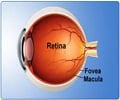Quitting smoking and maintaining normal cholesterol and blood pressure levels can help reduce the risk of heart attack.

Retinal Examination
Combining information about the pattern of blood vessels in the retina with genetic data can enable accurate prediction of an individual’s risk of CAD and its potentially fatal outcome, Myocardial Infarction (MI), commonly known as a heart attack. The discovery could lead to a simple screening process where an MI risk could be calculated when a person undergoes a routine eye test, researchers will tell the annual conference of the European Society of Human Genetics today (Monday).‘Quitting smoking and maintaining normal cholesterol and blood pressure levels can help reduce the risk of heart attack.’





“We already knew that variations in the vasculature of the retina might offer insights into our health. Given that retinal imaging is a non-invasive technique, we decided to investigate the health benefits we could obtain from these images. First, we studied the branching patterns of the retinal vasculature by calculating a measure named fractal dimension (Df) from data available from the UK Biobank (UKB). UKB includes demographical, epidemiological, clinical, imaging and genotyping data from over 500,000 participants across UK. We found that lower Df, simplified vessel branching patterns, is related to CAD and hence MI,” says Ms. Ana Villaplana-Velasco, a PhD student at the Usher and Roslin Institutes, University of Edinburgh, Edinburgh, UK.The researchers then developed a model that was able to predict MI risk prediction by studying UKB participants who had experienced an MI event after collection of their retinal images. The model included Df as well as traditional clinical factors, such as age, sex, systolic blood pressure, body mass index and smoking status to calculate personalized MI risk. “Strikingly, we discovered that our model was able to better classify participants with low or high MI risk in UKB when compared with established models that only include demographic data. The improvement of our model was even higher if we added a score related to the genetic propensity of developing MI”, Ms. Villaplana-Velasco said.
“We wondered if the Df-MI association was influenced by shared biology, so we looked at the genetics of Df and found nine genetic regions driving retinal vascular branching patterns. Four of these regions are known to be involved in cardiovascular disease genetics. In particular, we found that these common genetic regions are involved in processes related to MI severity and recovery.”
These findings may also be useful in identifying propensity to other diseases. Variations in the retinal vascular pattern also reflect the development of other ocular and systemic diseases, such as diabetic retinopathy and stroke. The researchers believe it is possible that every condition may have a unique retinal variation profile.
“We would like to investigate this further, as well as undertaking a sex-specific analysis. We know that females with a higher MI or CAD risk tend to have pronounced retinal vascular deviations when compared to the male population. We would like to repeat our analysis separately in males and females to investigate if a sex-specific model for MI completes a better risk classification,” says Ms. Villaplana-Velasco.
Advertisement
“So the calculation of an individualized MI risk from those over 50 years old would seem to be appropriate,” says Ms. Villaplan-Velasco. “This would enable doctors to suggest behaviors that could reduce risk, such as giving up smoking and maintaining normal cholesterol and blood pressure. Our work once more shows the importance of comprehensive analysis of data that is routinely collected and its value in the further development of personalized medicine.”
Source-Eurekalert















